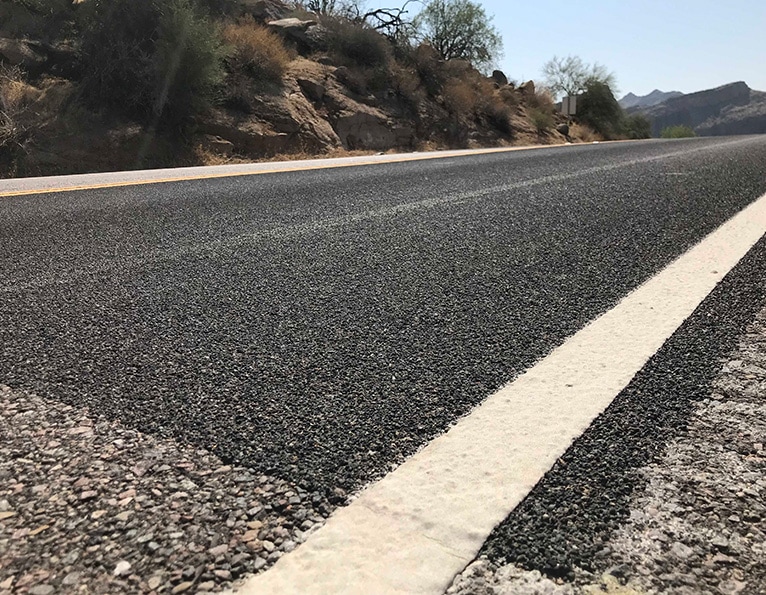HFST and its impact on road safety
Services: High Friction Surface Treatment
Mark Archer, International Technical Operations Manager at WJ Surface Treatments, discusses the benefits of high-friction surface treatments (HFST) and what to keep in mind when considering them.
40,990 people died in motor vehicle crashes on American roads in 2023i. According to the Federal Highway Administration, around a quarter of these will have taken place on horizontal curvesii, due to vehicle tyres losing traction with the road surface.
On horizontal curves, the vehicle speed coupled with the curve geometry creates a friction demand that exceeds the pavement surface friction. Intersections also see an increased friction demand from vehicles due to excessive speed and lateral movement.
Thankfully, there is a proven way to tackle this problem. Used on UK roads since 1967, high-friction surface treatments (HFST) only began to be adopted in the US in the 2000s. Consequently, many states are still unaware of their ability to reduce roadway departures and improve vehicle control in adverse weather conditions.
So, what is HFST exactly, and what are the benefits and challenges of using it?
HFST is a safety treatment whereby specialised, 100% calcined bauxite aggregate combined with a binder (glue) is applied to asphalt or concrete to enhance the coefficient of friction on the road surface.
Road surfaces identified as high risk typically contain aggregates with a polished stone value (PSV) of 58-65, this polished stone value combined with the surface texture creates the skid resistance of a road surface, the higher the PSV value the better the resistance. Bauxite aggregate which is used in high-friction surface treatment has a PSV of over 70, giving it the highest polished stone value on the market and providing an anti-skid surface unlike any other.
HFST vs other friction treatments
While there are many other surface treatments available for friction enhancement, no other treatment can provide the same level of skid resistance in a high-traffic stress areas for a prolonged period of time.
Micro asphalt: Micro asphalt is a bitumen slurry that is applied to an existing road surface. It is a good method for providing enhanced surface friction on roads, with low-speed limits. However, it isn’t designed to cope with high-speed and high-stress areas, using micro asphalt on stopping areas or curves would result in the system prematurely failing.
Diamond grinding: This is another method that can be used to enhance a road’s friction. This surface treatment cuts smalls grooves into the road. By adding these groves this improves the macro and micro texture of the road surface and prevents standing water which can cause skids during wet weather. However, the process of diamond grinding does not create the friction levels obtained through installing HFST.
Proven benefits of HFST
Ideal for sharp horizontal curves, intersections, highways and freeways, accident black spots, high-traffic areas, sidewalks, and approaching vehicle walkways, HFST has been shown to reduce wet crashes by 83% and total crashes by 57%iii.
Kentucky’s transportation cabinet has been implementing HFST on high-crash roadway departure sections across the state since 2009 to reduce the number of highway fatalities and serious injuries. Before the implementation of HFST, roadway departures accounted for 65% of all traffic-related fatalities, Since installing HFST yearly total crashes on curves have declined by 73% and on ramps by 78%v.
In one year alone data reported over 16 million intersection crashes in the U.S., resulting in over $664 billion total costs (which include economic cost components, such as emergency service costs and property damages, along with quality-of-life valuations). Each crash therefore costs over $41,000. In one field example on an intersection in Kentucky, the Ramp from I-75/I-64 to US-68/US-27, there were 25 crashes in the 3-years before HFST was applied and during the 3-years post HFST only one crash was reported, that’s a 96% reduction in crashes at one site and almost $1 million of savings. HFST typically costs around $25 per square yard, if it was adopted throughout the U.S. the total savings across the entire country could be huge.
As well as reducing accidents and saving lives, HFST offers several advantages to those responsible for road safety. If applied to sound substrates and properly maintained, it can last for up to 10 years, this means there is less need to resurface the road.
Another advantage is its speed of application and setting time. These reduce the need for prolonged road closures, maintaining traffic flow and ensuring safer driving conditions are implemented quickly.
High-friction surface treatments significantly enhance road safety and surface longevity. Not only is it a proven method for reducing the number of crashes on American roads – but also the best all-round solution for those responsible for road safety.
[i] National Highway Traffic Safety Administration
[ii] Federal Highway Administration
[iii] Federal Highway Administration
V Kentucky Transportation Cabinet’s High Friction Surface Treatment and Field Installation Program
Vi https://crashstats.nhtsa.dot.gov/Api/Public/ViewPublication/813403

